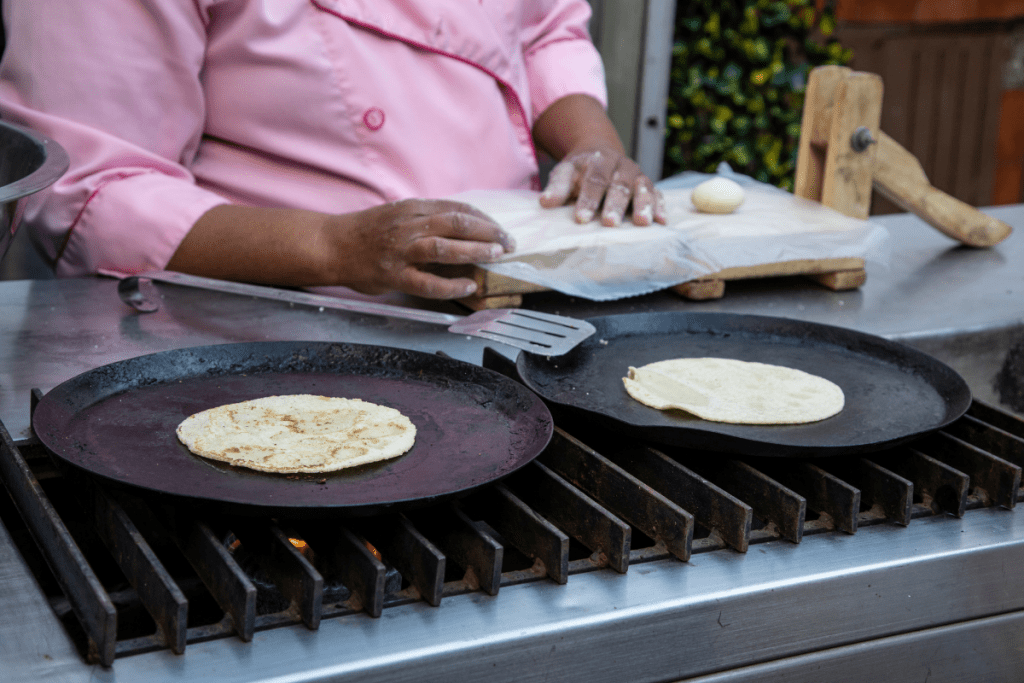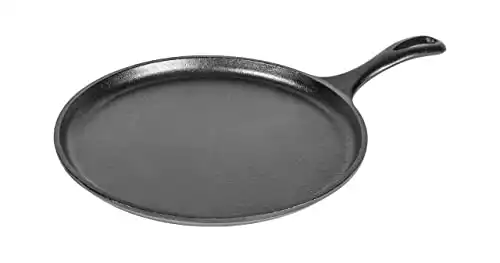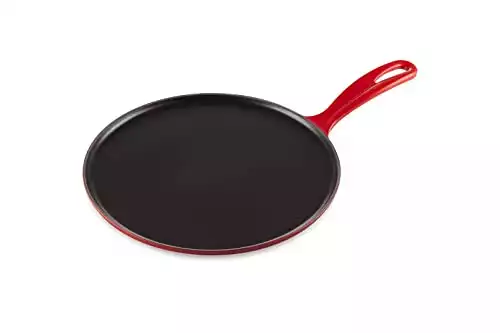Store-bought tortillas are fine, but is “fine” really what we want from our food? Not if you ask me.
Start making your own tortillas and you’ll never look back, but where to start. With the right pan of course!
Choosing the best comal pan can be a bit tricky, especially because they go by many names. Not to worry, I’ve done the heavy lifting for you. Using my professional cooking experience as well as hours of research, I’ve picked out three of the best comal pans for every kitchen and budget.
In This Article
Our Pick: Lodge 10.5-Inch Cast Iron Comal
he Lodge 10.5-inch cast iron griddle is the best comal pan for most home cooks. It’s a perfect size and weight, plus the heavy-duty construction means it will last forever. And, as a bonus, it’s the least expensive option you’re going to find.
This pan is made from solid cast iron. Making it heavy and durable. When it comes to cooking, the weight and density of the pan ensure heat is distributed evenly from edge to edge. That means the heat will also travel into the handle, so be sure to have an oven mitt or towel around while you’re cooking.
The 10.5-inch is a great size for cooking tortillas, arepas, and quesadillas, just to name a few. The short sidewalls make it easy to flip items in the pan but are also tall enough that you can use some oil without worrying about making a mess on your stove.
What we like
- Very inexpensive
- Excellent heat distribution and retention
- Incredibly durable
What We don’t
- Cook one tortilla at a time
- Raw cast iron requires some maintenance
For Larger Batches: Victoria 15-Inch Cast Iron Comal
If you’re looking to do some serious tortilla production, the 15-inch comal from Victoria will make the process fast and easy.
The Victoria comal pan is also made entirely from cast iron, so you know it’s going to heat evenly across the large cooking surface. Because this pan is so big, it also means it’s heavy, weighing over eleven and a half pounds.
The big benefit of such a large comal is that you can cook three or four tortillas at a time, as well as use it for larger flatbreads like dosa and roti. Or, it works great as a pizza stone in the oven or on a grill.
There is a flat, loop handle for carrying and storage, but it can be a little difficult to move around during use. Also, you’ll have to keep in mind that there are no raised sides. That means you’ll have to keep any oil usage to a minimum and liquids are pretty much off-limits.
If you plan on cooking a lot of tortillas or other flatbreads, this 15-inch comal will make quick work of it. Plus, the fact that it doubles as a pizza stone is an added bonus.
What we like
- The large diameter is great for making a lot of food
- Very even heat distribution
- Doubles as a pizza stone
What We don’t
- No sidewalls make it a little less versatile
- Raw cast iron requires some maintenance
Premium Option: Le Creuset 10.75-Inch Enameled Cast Iron Comal
The Le Creuset 10.75-inch enameled cast iron pan is like an upgraded version of my best overall pick. It’s functional, beautiful, and doesn’t require any seasoning or maintenance, but it’ll cost you.
Similar to my other picks, this pan is also constructed from cast iron. The big difference is that the cast iron is completely encapsulated in a durable glass enamel coating.
That means you get the durability and heat distribution like the Lodge and Victoria pans, but you never have to season it or worry about rust. That makes upkeep non-existent and you can even throw this pan in the dishwasher in a pinch.
The design and shape are very similar to the Lodge griddle. It has one comfortable and easy-to-use handle, and a flat cooking surface with a short raised rim.
So far, the Le Creuset sounds like a win-win, and it is a great pan. But, it also costs more than ten times as much as the Lodge griddle. This is no doubt an excellent option if it’s in your budget, but don’t expect wildly different or better cooking performance.
What we like
- No seasoning or other maintenance required
- Dishwasher safe
- Very good heat distribution and retention
What We don’t
- The price
What To Look For

The Best Size For What You Cook
A comal is great for cooking tortillas, but they are no one-trick pony. Depending on what size you choose, you’ll be able to make a wide range of dishes in the little (or big) pan. Many of the most common comals come in the 10 to 11-inch range.
These are easy to move around the stove and don’t take up much room in the cupboard. You can certainly use this size to cook tortillas, but you’ll only be able to cook one at a time. So, it can be a slow process if you are making a lot.
10-inch comals are usually built with a short raised rim. This makes it easy to flip things in the pan, but also opens up a lot of other cooking possibilities that require a little liquid or fat.
If 10-inches seems too small, you can jump up to the 12 to 15-inch range. These larger sizes are the way to go if you plan on cooking large quantities of tortillas, or large flatbreads like roti or dosa.
I also like a larger comal because it can double as a pizza stone that can be used in any oven. Many of the larger comal pans don’t have a raised rim. That makes them great for dry cooking, but won’t be very useful for anything that requires liquid or large fat.
Material: Even-Heat Is Key
One of the most common uses for a comal is cooking or reheating tortillas.
This is a pretty fast process and an evenly heated cooking surface will ensure evenly cooked tortillas. For that reason, I think that cast iron is the best choice. It heats very evenly, can handle any temperature you need it to, and will last a lifetime.
You can buy non-stick comals, but these have surfaces that are not very durable. Plus, they shouldn’t be heated without any liquid or oil in them. That makes it difficult to use for tortilla making, which requires a hot dry pan.
Shape: Round For The Win
There are a few different options when it comes to choosing the shape of your comal. Round, oval, or rectangular.
A round comal is going to be the easiest to use for most home kitchens. They fit nicely on most stovetop burners, resulting in an evenly heated cooking surface.
Oval comals are often a bit larger and must be used across two burners. This can be a good option when cooking larger quantities, but it can be tricky getting the temperature right.
Rectangle comals are just like the large griddles that most of us are probably used to. This is a good option if you’re cooking for very large groups, but can be too big for many daily uses.
Keep Your Comal Pan In Tip-Top Shape
Since the best comal pans are made from cast iron, you’ll have to take a little care to keep them from rusting. That means seasoning your pan initially, and then taking some extra precautions when you wash it.
Check out my preferred method for seasoning cast iron or carbon steel pans. And when it comes to washing, hot water, and a stiff brush should do the job. After that, it’s important to keep your pan very dry between uses to further keep rust at bay. Or you can skip the maintenance altogether and go with the enamel-coated Le Creuset pan.
What You Can Expect To Spend
A 10-inch cast-iron comal should never really cost more than $30 unless of course, you go for an enameled cast iron model. Then, you can spend well over $100. For the larger 12 to 15-inch cast-iron models you can expect to spend between $20 and $60.
My Recommendations
You simply can’t deny the value and functionality of the Lodge cast iron comal, which makes this choice almost impossible to beat. Buy it for the tortillas, keep it for the pancakes and grilled cheese sandwiches. Or, if you need some more serious production, the Victoria 15-inch comal is big enough to turn any kitchen into a miniature tortilla factory in no time.
FAQ
What is a comal used for?
A comal is a multipurpose cast iron pan that is traditionally used for cooking tortillas, charring vegetables and meat, toasting nuts and spices. You will find this cookware staple in kitchens across Mexico, Central and South America. The comal is incredibly similar in shape and function to crepe pans and griddles that are popular in other food cultures.
How do you prepare a comal before using it?
Cast iron comals must be seasoned in order to keep them from rusting and to help keep food from sticking. My favorite method for seasoning cast iron is the same one I use for seasoning carbon steel. As the pan sits over medium heat, a very light coat of oil is applied. This process is repeated as each layer of oil is essentially burnt onto the pan, creating a protective barrier.
Do Chefs use comal pans in professional kitchens?
In many professional kitchens, a comal is replaced by large cast-iron griddles or planchas. They serve the same purpose but can be used to cook much larger quantities at a time
What Should I make in my Comal?
If you buy a comal, definitely give homemade tortillas a try. It doesn’t matter if you prefer corn or flour, freshly made tortillas are miles apart from the ones you buy packaged in most mega stores.
What is a tortilla pan called?
A comal is a flat cast iron griddle that is traditionally used for making tortillas in Central and South America.
Do You need a comal to make tortillas?
A traditional comal isn’t essential if you’re making tortillas. For most at-home chefs a griddle or crepe pan will work just fine.
Is a comal a griddle?
The terms “comal” and “griddle” originate from different food cultures, but they are essentially the same pan. Compared to a low round griddle, a comal will sometimes have a wider base and slightly lower edges.










